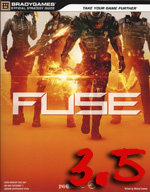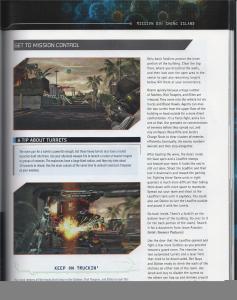 Fuse was completely off my radar until the demo released about a month before the game’s launch. I shouldn’t have been as surprised by it as Insomniac traditionally makes fun games, but for whatever reason, the game didn’t appeal to me until I played it. However, I had much higher expectations for the strategy guide, most of which sadly came up short. While the Fuse strategy guide did plenty very well–and I wish I had paid more attention to some things–a couple of aspects were not handled well at all and actually detracted from my game playing experience.
Fuse was completely off my radar until the demo released about a month before the game’s launch. I shouldn’t have been as surprised by it as Insomniac traditionally makes fun games, but for whatever reason, the game didn’t appeal to me until I played it. However, I had much higher expectations for the strategy guide, most of which sadly came up short. While the Fuse strategy guide did plenty very well–and I wish I had paid more attention to some things–a couple of aspects were not handled well at all and actually detracted from my game playing experience.
Unless the strategy guide is for an RPG, I rarely read the front few sections about the characters, enemies, etc. With shooters, it’s quite rare that you get to select characters with different abilities, much less characters that have skill trees. Fuse has both, so it’s actually vital to read this initial chapter to not only find out which of the four characters is best suited for your personal gameplay, but also how to optimally upgrade each character’s skill tree. The skill trees for the most part all look the same save for each character’s unique Xenotech weapon and ability, but it’s the character’s unique ability that dictates which skills are best for upgrading as soon as possible and which can be saved for later. I, sadly, did not read this section until about 2/3 of the way through the game, and I wanted to kick myself instantly. I knew off the bat that I had picked the wrong character as my mainstay, but to learn that I hadn’t leveled up my character as well as I could have was another blow. When I read the author’s explanations for why I should be upgrading Izzy this particular way, I nearly had an epiphany. Why hadn’t I thought of that? I will never ignore this type of section again when tasked with choosing characters, no matter how insignificant it may seem to be.
What bothered me the most was that the Fuse strategy guide contained zero maps. Having maps for each scene would have helped clear up massive amounts of confusion with some of the wording of the strategy guide for starters. The real reason why I’m miffed there are no maps is because Fuse has lots of collectibles, and one of them leads toward an Achievement/Trophy. Much like the Resistance games, Fuse has intel collectibles that offer a bit of background to the story, Xenotech, characters, etc. They aren’t vital to the game, but they’re interesting, and players who find them all will receive an Achievement/Trophy for doing so. Words cannot express how useful it would have been to have maps marking all of the intel as well as the other extremely useful collectibles (Like XP and credits! What I could have bought and leveled up by finding all of these…)
The intel were not even pointed out via handy call-out boxes complete with screenshots. Instead, they were mentioned in bold font in the walkthrough itself, as shown in the image on the right. As a result, I felt like I was reading the strategy guide more than I was actually playing, and it greatly affected how quickly I could get through a section. I was constantly pausing between gun fights/exploration to ensure I wasn’t missing intel. Even worse, not all of the intel was properly mentioned in the walkthrough. I was missing three pieces of intel at the end of the game, and in comparing the list of intel in the appendices in the back of the guide with the walkthrough, there are exactly three intel omitted from the walkthrough.
Specific Achievements/Trophies, however, did receive their own call-out boxes (see image on right), and thanks to them, I was able to earn all of the weird Achievements. These included odd little stipulations such as stealth-killing a soldier in a particular level while he’s using a urinal. Special mentions like these are always greatly appreciated.
In addition, the strategy guide had a nice little section in one of the appendices that offered suggestions for where to earn other Achievements. For example, the “Shots Fired!” Achievement requires players to pin 3 enemies within a 10-second time frame. The Achievements appendix advises which character to use and where in the game is easiest to accomplish this feat.
Fuse doesn’t have a traditional multiplayer mode like so many shooters do, but instead has a co-op mode, called Echelon mode, that functions very much like Horde Mode in Gears of War. However, players can play this extra mode solo, and the Fuse strategy guide devotes much of the advice in its Echelon mode section to how to survive on your own. I really think this is the first time I’ve found a non-campaign section of a strategy guide to be immensely useful. Each map for Echelon mode has its own tips and own suggestions for which characters to use to get through it alone.
My overall rating for the Fuse strategy guide may seem overly harsh, especially since the strategy guide does so many things very well. Its lack of maps and omission of a few collectibles ended up hurting my experience with the strategy guide the most. With these two issues fixed, the Fuse strategy guide would have been downright perfect.
SGR Rating: 3.5
Author: Michael Lummis
Publisher: BradyGames
Editions available: Paperback
Acquired via publisher





Leave a Reply